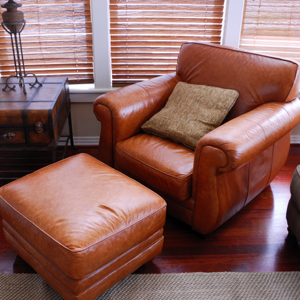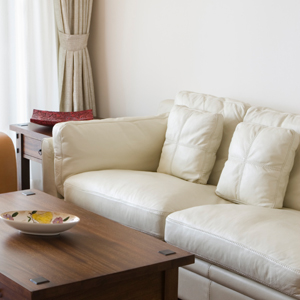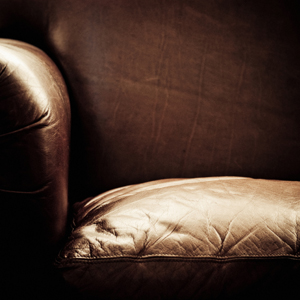 |

As you shop, take into account that the type of leather, the grade of leather, the thickness of the leather and where the sofa was made (country of origin) all contribute to the price tag.

If you have an active family with children or pets, you may want to consider protected or pigmented leather.

Aniline leathers are beautiful, soft and supple and will develop a patina over time. They look great with age, but over time they may need to be conditioned.
Aniline leathers are beautiful, soft and supple and will develop a patina over time. They look great with age, but over time they may need to be conditioned.
Ask Your Sales Associate
When shopping for leather, read labels and ask. If you want genuine leather, ask your sales associate about the contents and the quality of the leather.
-
Leather, A to Z
Everything you need to know to shop for leather furniture.
- by Joan Gunin
When shopping for leather upholstery, this once considered out-of-reach luxury item is now more widely affordable because of the range of leathers available. But before you buy that new sofa, accent chair or recliner, first determine the type of leather that will best suit your family’s lifestyle. Choosing the right leather will make you a lot happier.
Leather Categories and Pricing
“People need to understand the natural characteristics of the leather they choose and to make sure it matches their expectations,” says Phil Brown, merchandise manager for leather and chairs at Century.
At the high end, “Aniline leathers are beautiful, soft and supple and will develop a patina over time,” Brown says. “They have a better hand and look great with age, but over time they may need to be conditioned.”
While anilines are great for adult living, Brown says that if you have an active family with children or pets, you may want to consider something with more protection. For instance, if you’re placing the sofa in direct sunlight, Brown says to go with protected or pigmented leather like “Aniline Plus,” a semi-aniline from Century.
It also helps to know the difference between a natural aniline, a split versus a top grain, a corrected leather and something new known as bonded leather.
To help in your decision-making, visit some stores and compare the touch and feel of a luxurious naked aniline with a sofa dressed in corrected leather. The aniline may be ultra soft and thick but out of your price range. The other may look good and feel good too but prove a better fit for your pocketbook. Or you may choose something in-between.
As you shop, in addition to color, size and style, take into account that the type of leather, the grade of leather, the thickness of the leather and where the sofa was made (country of origin) all contribute to the price tag.
All about Tanning
Before it can become that bomber jacket-soft leather sofa you sink into, raw cowhide first undergoes a complex production process called tanning.
Chemicals are used to strip, smooth, soften and preserve the hide. Chromium is a common tanning agent but if you are keen on environmental causes, some producers such as Green Hides use ecologically friendly vegetable-based “green” agents instead. After the hides are stripped of hair, fat and residue, the “crusts” are dried in huge drums.
The Range of Leather
The finest leather, pure aniline, made from thick, full grain hides, is free of any other color or pigment. Top or full grain is considered the best and is priced accordingly. Just remember: Top grain means top quality.
One step below is semi-aniline, an aniline treated with protective coating to retain its natural color. While the best hides become anilines, less desirable hides—those flawed by insect bites, brands or fencing—can be sanded or buffed. This reconditioning, similar to covering a skin blemish with makeup or spackling a wall, results in pigmented or “corrected” leather. Because it has been reconditioned to appear perfect, corrected leather costs less than aniline.
Also commonly used are “splits,” where lesser hides are separated from the top grain into layers. These under layers or “splits” are finished to resemble top-grain leather. Splits are often used on the sides and backs of frames, resulting in greater savings to you.
The price tag is always a clue to the type of leather you are buying, with top grains running about $400 or more (at retail) than corrected leathers, says Lee Fautsch, vice president of sales, home furnishings for Flexsteel Industries.
Some hides may undergo further finishing, glazing or embossing before being cut—either by hand or machine—(with hand cut being costlier) which again affects the price.
If you're shopping for authentic leather furniture, be aware of bonded leather. This affordable “leather-look” covering has the look and feel of leather—and is often labeled as such—but it’s actually a man-made mix of polyurethane, fibers, latex and leather scraps. The total leather content is about 10 percent to 17 percent, and it doesn't go through the tanning process. Bonded leather may mimic the grains or patterns of leather hides, but it does not wear or age like leather.
Leather that Makes the Grade
Another thing to consider in choosing a leather is the grade. Manufacturers use individual grading systems—usually letters (A, B, C…) or numbers (1, 2, 3…)—to price their leathers for retail stores. This method allows manufacturers and retail stores to easily distinguish their best anilines from less costly corrected counterparts.
While these grading systems work within each manufacturer’s line, they can't be compared between manufacturers because no two companies are alike—and neither are their leathers. So it’s wise to ask about leather grades to know if you’re getting a deal on a decent mid-grade leather, for instance. Again, touch and feel the leather to see if it warrants the price.
Affordable Frames
Another characteristic that affects the price is where the frame was made. While Italy has long had a tradition for quality leathers, today lower labor costs in such countries as China are reflected in lower price tags. Sure, a sofa may boast “Italian leather” because the hides were tanned there, but they may have then been shipped to China to be produced. Again, this will be reflected in savings for you. “Leather is an overwhelming value in the marketplace today because of the tremendous price, value and quality that is being sourced from overseas (China),” Fautsch says.

